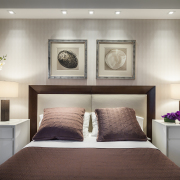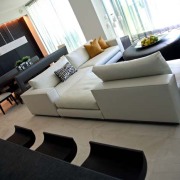TIPS FOR HANGING PICTURES
With my hectic days, I don’t really have much time to write, but I do like to read… and as usual, I like to share with you interesting articles that I come across.
Here few useful tips when hanging pictures at home – I do really enjoy DYI Network! : ) Enjoy.
“If the space includes a large wall and a lot of floor space, make some decisions by arranging the artwork on the floor first. Measure how far they need to be from one another. Then take one at a time and put them up on the wall.
Another option is to make a template of each piece to be hung. Just trace around the outside of the frame on kraft paper, cut out the shape, and label it. Also draw an arrow on it to indicate whether the art is vertical or horizontal.
Secure the templates to the wall with a product known as reusable adhesive, which looks a bit like putty or chewing gum. It won’t tear pieces from the wall or the paper patterns.
Consider grouping four small same-size pictures together in a four-square, to give the illusion of a larger picture.
There doesn’t always have to be four in a group. Consider using a larger picture in the center. Then place two smaller pictures on either side of the large picture, spaced vertically to about equal the length of the larger frame. Or, in place of the larger picture, use a large mirror.
Not all frames will always be matching sizes, so approximate and just try to balance the impact of the frames — not match them perfectly.
Always hang pictures at eye level.
If hanging a picture over a sofa, don’t leave a lot of wall space between sofa and picture. Try for three to six inches. If you go any higher, the viewer’s eye will just go to the wall, not the picture.
Don’t put one little picture on a large wall. It looks ridiculous. If there’s not enough artwork to fill up more space on a large wall, consider putting mirrors or a shadowbox in the grouping.
Conversely, don’t overload a small wall with a large picture.
Consider resting pictures on shelving hammered directly on to a wall. Or display them on a plate rack in place of plates.
Nor do pictures always need to be on a wall. Consider a bamboo easel for an Asian-inspired decor. There are also wrought-iron or wood easels available, so choose one that complements the look of the home.
There are lots of ways to enhance how pictures are displayed with picture nails and various knobs.
As for physically hanging the pictures on the wall, look for a picture-hanging kit at the hardware or home store. It will include everything you need. And keep in mind, the picture’s weight will determine what size hook to use. For a very large picture, use two hooks.
Also consider the many decorative eye screws available for hanging pictures. Screw them to the top of the frame and then dangle the frame from a wire attached to a screw in the wall. Instead of wire, consider using decorative French ribbon to hang the frame from the wall.
For photos that will be displayed together, consider having all the photos framed compatibly. The frames can be in various patterns of the same color or material and should all have the same mat color. Mixing wood-framed pictures with metal-framed pictures works best in an eclectic home. For a more formal look, try to keep the same color for all the frames. Arrange the frame variety on the wall to form a gallery-style display.”
http://www.diynetwork.com/decorating/tips-for-hanging-pictures/index.html





